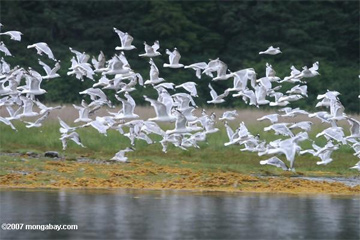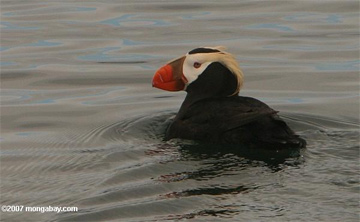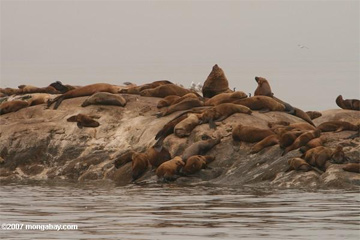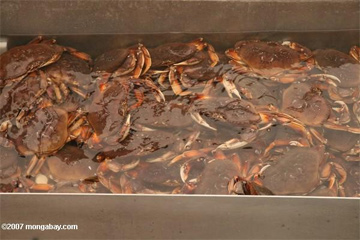Global warming will hurt fish catch in the Bering sea
Global warming will diminish fish catch in the Bering sea
Jeremy Hance, mongabay.com
January 16, 2008
|
|
One half of the fish caught in the U.S. annually—and almost a third worldwide—come from the Bering Sea. Yet, this vast resource is increasingly threatened by climate change. A recent study, published in Marine Ecology Progress Series, showed that global warming will greatly affect the Bering Sea’s phytoplankton, the cornerstone of the sea’s rich ecosystem. “It’s all a good start that people get worried about melting ice and rising sea levels. But we’re now driving a comprehensive change in the way Earth’s ecosystem works—and some of these changes don’t bode well for its future,” said marine ecologist Dave Hutchins, whose former student at the University of Delaware, Clinton Hare, led the research in the Bering Sea.
The Bering Sea’s unusual productiveness is due to diatoms, a large phytoplankton, of which there are approximately 100,000 species. “Because they’re large, diatoms are eaten by large zooplankton, which are then eaten by large fish,” Dr. Hutchins explained. But in the study scientists found that a warmer Bering Sea would support only smaller phytoplankton, creating a vastly different, less-productive ecosystem. “The food chain seems to be changing in a way that is not supporting these top predators, of which, of course, we’re the biggest,” Dr. Hutchins said.
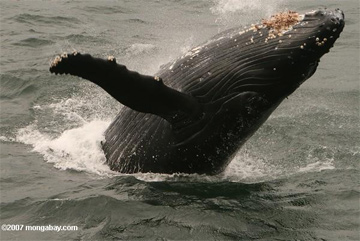 Humpback whale in Alaska
Photos by Rhett A. Butler |
To perform the study, scientists collected samples from the sea and incubated the phytoplankton in the conditions predicted for surface temperature and carbon dioxide concentrations in 2100. Researchers discovered that while photosynthesis in greenhouse water samples rose above two to three times current rates, the species shifted from diatoms to the smaller nanophytoplankton. Though the study focused on future temperatures and carbon levels, Dr. Hutchins describes the Bering Sea as “a canary in a coal mine because it appears to be showing climate change effects before the rest of the ocean.”
A less productive Bering Sea means a very different American diet. “All the fish that ends up in McDonald’s, fish sandwiches—that’s all Bering Sea fish,” stated Dr. Hutchins. “The experiments we did up there definitely suggest that the changing ecosystem may support less of what we’re harvesting—things like pollock and hake.” Aside from fast food restaurant fare, the Bering Sea catch is commonly used for frozen fish sticks and similar products in grocery stores. Other commercial species include Pacific salmon and red king crab. It is estimated that fisheries in the Bering Sea accrue a billion dollars annually in the United States.
The Bering Sea is home to much more than fish. There are numerous marine mammals, like polar bears, walruses, and sea lions. Cetaceans include the bowhead whale, blue whale, fin whale, sei whale, sperm whale, orcas, belugas, and the Northern right whale. Over thirty species of birds breed in the region. Many of these species are already threatened by warming according to Dr. Hutchins, “marine mammals and birds are having massive die-offs… —in general, it’s changing to a more temperate ecosystem”.
To further the knowledge of warming seas across the globe, Dr. Hutchins and other scientists are conducting similar research in the north Atlantic Ocean and the Ross Sea near Antarctica. “We’re trying to make a contribution by doing predictive experimental research that will help us understand where we’re headed,” Dr. Hutchins said. “It’s unprecedented the rate at which things are shifting around.”
